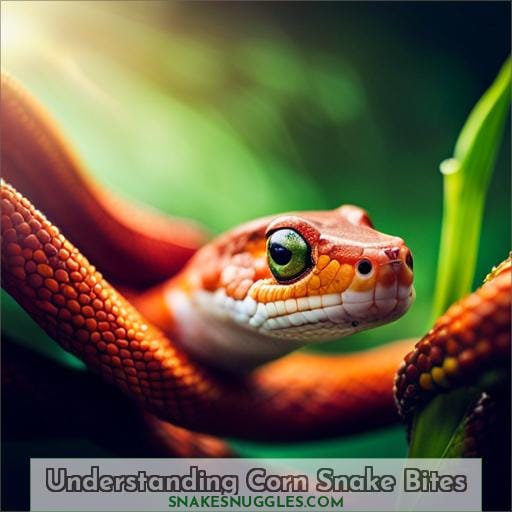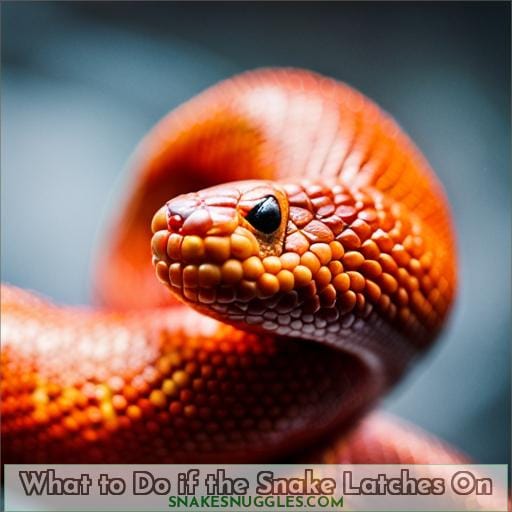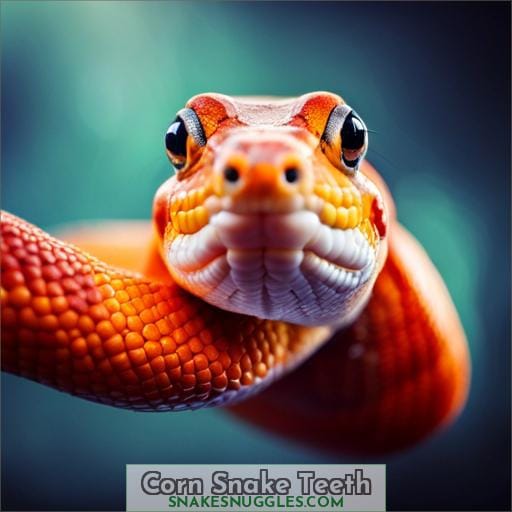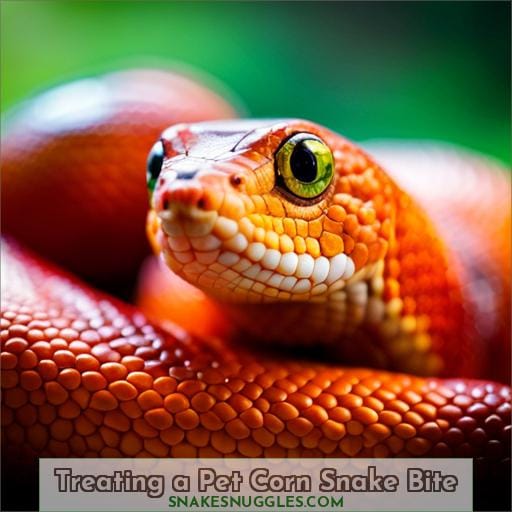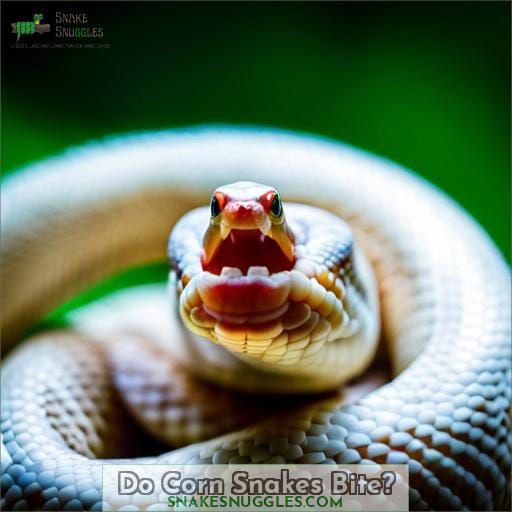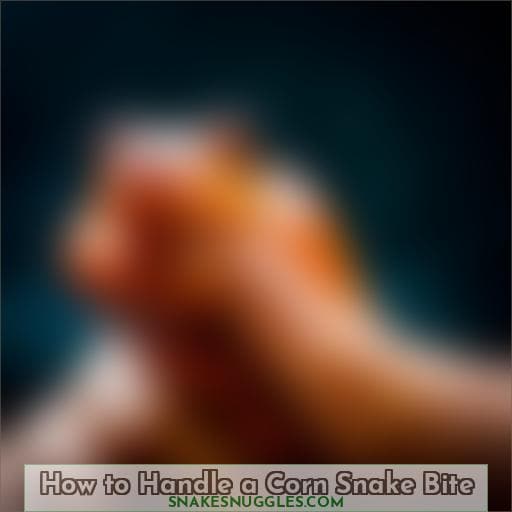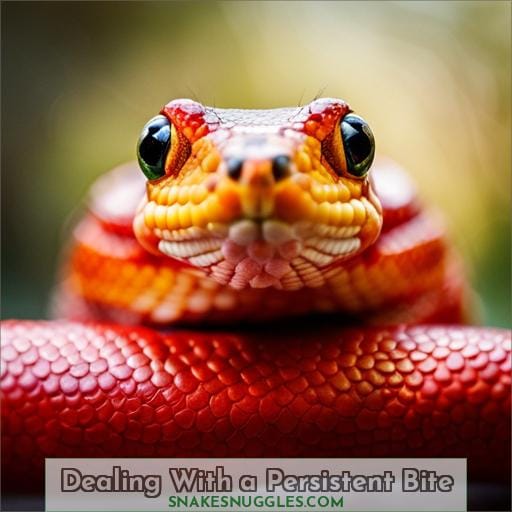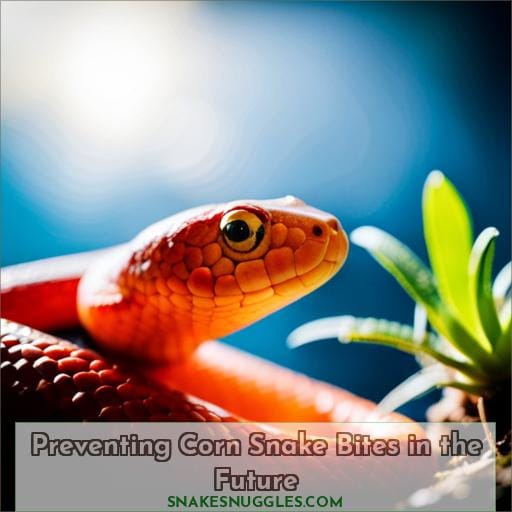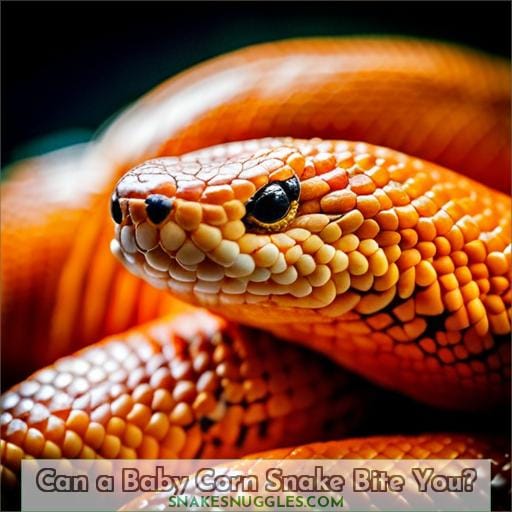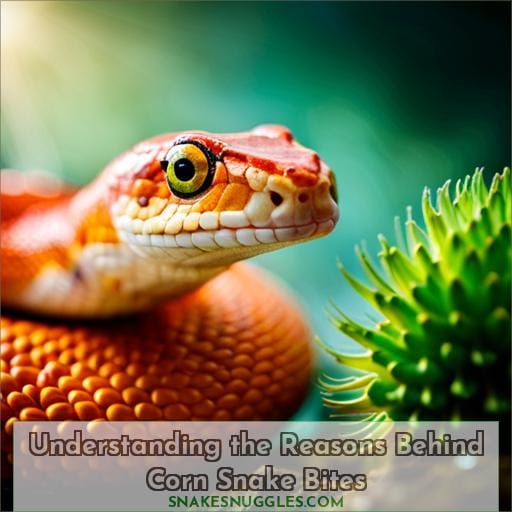This site is supported by our readers. We may earn a commission, at no cost to you, if you purchase through links.
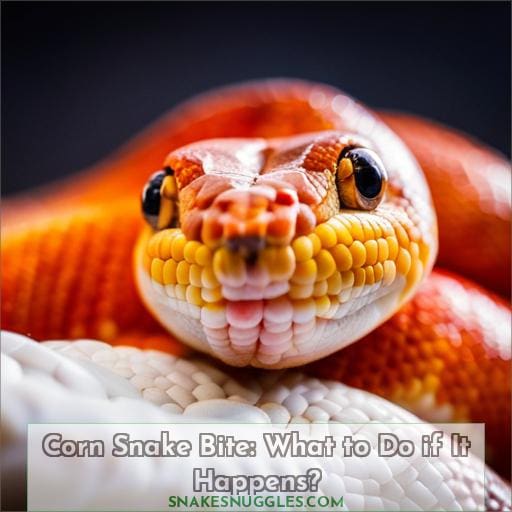 Are you worried about a Corn Snake bite? If so, you’re not alone. As one of the most popular snakes in captivity, many people are concerned that their pet may try to take a nibble out of them.
Are you worried about a Corn Snake bite? If so, you’re not alone. As one of the most popular snakes in captivity, many people are concerned that their pet may try to take a nibble out of them.
This species is generally docile and friendly when kept as pets; they rarely ever latch onto an owner or handler. In this article, we’ll cover all the necessary information related to corn snake bites: What to do if it happens, how Corn Snakes’ teeth work, and why these creatures might decide to bite in certain circumstances.
So read on for more details – we’ve got your back!
Table Of Contents
- Key Takeaways
- Understanding Corn Snake Bites
- What to Do if the Snake Latches On
- Corn Snake Teeth
- Treating a Pet Corn Snake Bite
- Do Corn Snakes Bite?
- How to Handle a Corn Snake Bite
- Dealing With a Persistent Bite
- Preventing Corn Snake Bites in the Future
- Can a Baby Corn Snake Bite You?
- Understanding the Reasons Behind Corn Snake Bites
- Frequently Asked Questions (FAQs)
- Conclusion
Key Takeaways
- Corn snake bites are generally harmless and rarely cause serious harm.
- Baby corn snakes might bite due to inexperience and feeling threatened.
- Sudden movements can startle corn snakes, leading to defensive bites.
- Understanding signs of stress, such as hiding and refusing to eat, is crucial.
Understanding Corn Snake Bites
It’s important to be aware that Corn Snakes can bite, even though they’re generally docile pets – so brush up on your knowledge and stay in the know!
A corn snake’s teeth are set in four rows of twenty to thirty sharp, backward-angled teeth. Though not venomous like fangs, these specialized tools help them constrict their prey and move food along their gullet.
Bites feel more like a pinch than anything else but may draw a bit of blood if you’re unlucky enough to have one latch onto you.
Baby snakes tend only to tap while adults will often pinch slightly harder due to stronger muscles. Overfeeding or handling too much during shedding are two causes for bites, as is sudden movement from an owner which could surprise the pet snake into feeling threatened and lashing out defensively with its mouth instead of retreating away as it normally would do when scared or stressed by something new in its environment.
When bitten by a corn snake, it’s important not to yank off if latched on – rather let go naturally. Then cleanse the wound using antiseptic soap and water before applying Neosporin (or hydrogen peroxide) for good measure after washing hands thoroughly beforehand.
To avoid any potential health issues altogether, there are simple steps owners can take. These include providing adequate hiding places within the vivarium/terrarium and regular feeding times without overfeeding.
Always handle with correct technique and patience while avoiding loud noises around your pet at all costs. Understanding what message lies behind each bite helps improve the relationship between owner and reptilian companion alike®.
What to Do if the Snake Latches On
If the snake latches on, remain calm and take steps to gently remove it. Corn snakes have around 20-30 sharp, backward-angled teeth that are meant for gripping and digestion rather than injecting venom.
Bites usually feel like a pinch or tap when coming from a baby corn snake, while an adult’s bite will be more pronounced.
Do not attempt to yank off the snake if it is latched onto you. Instead, use cold water or high percentage alcohol as gentle methods of removal. Cleaning the wound with warm water and antibacterial soap is important afterwards, as mouth bacteria can cause infection in humans if left untreated.
Applying antiseptic such as Neosporin or hydrogen peroxide may also help prevent any further issues arising from the bite itself.
It’s useful to understand some of the reasons why corn snakes might latch on in order to better manage future interactions with them. Overhandling, sudden movements due to surprise caused by loud noises, stress due to food scent confusion (washed hands before handling!), and poor handling technique during shedding periods all contribute towards making them uncomfortable.
This could result in latching behavior, even though their teeth were never designed for this purpose.
Patience and understanding go a long way towards improving your relationship with these docile creatures. So try avoiding sudden movement or noises where possible, along with proper management techniques such as providing hiding places within their enclosure space and maintaining cleanliness at all times.
Both are key factors contributing toward reducing potential stress levels, among other things.
Corn Snake Teeth
Corn snakes, also known as Red Rat Snakes, are non-venomous and popular pets. With four rows of sharp, backward-angled teeth on the top jaw and two rows on the bottom, they can have up to 30 teeth but no fangs.
Although corn snake bites may feel like a pinch or draw some blood due to their gripping and digestive purpose rather than injecting venom, these snakes rarely bite humans in general.
How Many Teeth Do Corn Snakes Have?
You may have noticed that corn snakes possess numerous teeth – around 20-30 sharp, backward-angled ones, to be exact. These non-venomous snake teeth are designed for gripping and digestion rather than injecting venom.
Corn snake bites usually don’t require medical attention, but proper care is important to reduce the risk of infection.
Enclosure maintenance helps prevent bites due to overstimulation or food shortage. Avoiding scent confusion by washing hands before handling can also play a role in bite prevention.
Understanding their behavior will go a long way in helping you better interact with them without causing any harm or discomfort on either side.
Do Corn Snakes Have Fangs?
No, corn snakes lack fangs – just rows of sharp teeth designed for gripping and digestion. They have four rows on top and two on the bottom, which help them constrict prey or move food along their gullet.
Venomous snakes possess hollow fangs to inject venom, but pet snake bites are usually harmless and not cause for concern. To prevent bites, maintain a comfortable environment free from environmental stressors.
Handle gently with proper technique and avoid loud noises or sudden movements that may startle the snake.
When bitten by your pet corn snake, it’s important to stay calm. Cleanse the bite wound with warm water and antiseptic solution, then apply a bandage if needed. Provide space for the animal as it recovers from its reaction to being startled or stressed out in its home environment.
Understanding and respecting your corn snake’s behavior is key when owning any type of beginner-level pet reptile!
Are Corn Snakes Poisonous?
Although corn snakes lack venom-producing glands, it’s important to understand their behavior and take proper precautions when handling them. Corn snakes are not venomous, but their bites can cause pain and infection if not managed properly.
Proper pet care is essential for snake bite prevention. To ensure safety during handling, use slow movements and keep the environment calm to reduce stress on the snake. If bitten, stay calm. Gently unwrap constriction as needed or drip cold water or high % alcohol onto a latched snake until it detaches naturally.
Then, clean the wound with warm water and antibacterial soap and apply antiseptic like Neosporin or hydrogen peroxide for further protection against bacteria in the corn snake’s mouth.
Educating yourself on the consequences of mishandling will help you maintain a happy relationship with your reptilian companion while keeping both safe from harm!
Treating a Pet Corn Snake Bite
If you’re ever unfortunate enough to experience a pet corn snake bite, it’s important to take the proper steps for treating and preventing such occurrences in the future. To ensure safety, avoid overhandling your pet and provide sufficient hiding places within their enclosure.
When bitten, remain calm and don’t yank away – instead, use cold water or high percent alcohol to remove them if latched on. Afterward, cleanse with warm water containing antibacterial soap and apply an antiseptic like Neosporin or hydrogen peroxide before covering with a bandage if necessary.
Most bites are minor but carry bacteria from their mouths, which can cause infection if not cared for properly.
When handling your snake, make sure you wash hands beforehand so as not to confuse food scent while also staying aware of signs that indicate potential biting behavior, such as shedding stress, hunger, or sudden movement due to a lack of patience during interaction, which could startle them into attacking out of fear.
Make sure they have space after being handled too, so they feel safe again afterwards.
Bite prevention is key by regularly feeding according to schedule while providing appropriate environmental conditions free from stressful elements like loud noises when interacting with pets.
Do Corn Snakes Bite?
Do you ever wonder if corn snakes bite? Although they are generally docile and friendly, it is worth understanding the potential risks that come with owning a pet corn snake. Are they venomous? Do corn snakes have teeth or fangs? Answering these questions will help to better understand how to handle and care for them safely.
Are They Venomous?
You might be surprised to learn that corn snakes aren’t poisonous, despite their sharp teeth. They lack venom glands and don’t pose a risk to humans when handled properly with the right technique.
Hungry snakes may bite as a form of defense or for feeding purposes. To ensure snake safety, it’s important to take proper care. This includes providing hiding places and maintaining a clean environment. It’s also important to avoid handling them during shedding or overhandling in general.
Additionally, washing hands before touching can minimize food scent confusion. This could cause biting behavior due to mistaken identity by hungry pet snakes.
| Venomous Snakes | Non-Venomous Snakes | |
|---|---|---|
| Have venom glands | Lack venom glands | |
| Injects poison into prey/humans upon bite | Grips onto prey/humans without injecting anything | |
| − Bite causes pain & potential infection | Bite feels like pinch & won’t infect you | |
| − Potentially life-threatening if untreated | Harmless unless wound becomes infected |
Do Corn Snakes Have Teeth or Fangs?
You’ll find that corn snakes’ mouths are equipped with sharp, backward-angled teeth instead of fangs for gripping and digestion purposes. Although they lack venom-producing glands, it’s important to handle them safely as any bite can carry bacteria from their mouth.
To avoid bites, provide hiding places in the enclosure and keep the environment clean to reduce stress levels. Wash your hands before handling so food scent won’t confuse or agitate them. This also helps prevent overhandling, which is a key factor of snake aggression leading up to a bite.
If bitten by an adult corn snake, you may feel a pinch. Baby bites will be more like taps on the skin but should still be taken seriously as all bites have risks associated with them, no matter how small or harmless they may seem at first glance!
Pet care tips, such as regular feeding schedules, alongside proper handling techniques, will help increase safety during interactions while also allowing for better understanding of each other’s behavior – essential when striving towards mastery in pet ownership!
How to Handle a Corn Snake Bite
When it comes to a corn snake bite, it is important to stay calm and gentle. Give your snake space and take care of the wound by cleaning it with warm water and antibacterial soap. After applying antiseptic, such as Neosporin or hydrogen peroxide, secure a bandage if needed for minor bites.
Stay Calm
Remain still and take a deep breath when you feel the pinch of a corn snake bite. To prevent bites, handle your pet gently with safe handling techniques to understand typical docile behavior. Bite prevention should include regular feeding schedules, avoiding handling during shedding, providing hiding places, and maintaining a clean environment.
Wound care is necessary as corn snakes carry mouth bacteria, so wash the area with warm water and antibacterial soap before applying antiseptic or hydrogen peroxide if needed. Most bites are minor, but a secure bandage may be necessary in some cases. Understanding why your pet bit will help create better interaction between you over time.
Be Gentle
Gently remove the snake if it’s latched, allowing it to detach naturally. To ensure proper care and safety while handling a corn snake bite, always use gentle techniques when interacting with the pet. Avoid sudden movements or loud noises that can cause further distress for your docile friend.
Provide enough space between you and the snake so that they feel safe after biting. This will help prevent future aggression signs from appearing again in the future. Clean any wound areas properly with warm water and antibacterial soap, followed by an antiseptic such as Neosporin or hydrogen peroxide.
Avoid infections from bacteria found within their mouths, as it is essential for both parties involved.
Lastly, adopt preventive measures like regular feeding schedules and providing hiding places to reduce stress levels of your pet before attempting any kind of interaction or even handling them directly.
Give Your Snake Space
After being bitten, allow your snake some respite by giving it space to settle. Avoid handling before feeding and during shedding as this could lead to bites. Provide a comfortable enclosure with hiding places and regular feedings. Maintain the habitat cleanly for optimal bite prevention.
Poor handling or an unfamiliar environment can cause stress in snakes, leading them to bite out of fear or anxiety. Be gentle when using proper technique and keep noise levels low. Give your snake distance if they show signs of distress, such as raising their head up high, which indicates possible aggression.
Take Care of the Wound
Clean the bite wound with warm water and antibacterial soap, then take care to apply antiseptic – such as Neosporin or hydrogen peroxide.
- Follow a regular feeding schedule; avoid handling during shedding.
- Handle gently and understand your snake’s behavior for better interaction.
- Cleanse the wound often, disinfect it, and secure a bandage if needed. With proper safety measures in place, corn snakes can be enjoyed without fear of bites!
Dealing With a Persistent Bite
If you find yourself in the situation of a persistent corn snake bite, it can be difficult to know what to do. It’s important that you stay calm and avoid sudden movements as this will increase their biting pressure.
To prevent bites from occurring in the first place, maintain regular feeding schedules and ensure your snake has hiding places for security. When handling snakes, always wash your hands before touching them to avoid food scent confusion.
Use proper technique; handle gently with minimal duration while avoiding loud noises or over-handling as this may cause stress on the animal, which could lead to biting behavior due to its natural defense instincts kicking in.
When attempting to remove a latched snake, never yank it off as this will only increase its grip. Instead, use cold water or high percentage alcohol slowly dripping onto its head until it releases itself naturally after several minutes of soaking up moisture (this depends on how long they have been latched).
Afterwards, cleanse both the wound area with warm water and an antibacterial soap such as Betadine, followed by applying antiseptic ointment like Neosporin or hydrogen peroxide if necessary, then bandaging when required (most bites are minor though).
In order for proper healing post-bite incident, assess severity using mild disinfecting agents according to the dictionary’s definition: Cauterize, meaning burning tissues using heat through a cautery instrument by qualified personnel at a medical clinic/hospital setting.
React calmly so as not to aggravate any further reactions, and understanding body language signals sent out by pet reptile species helps determine underlying issues causing these episodes from happening, thus preventing future accidents.
Preventing Corn Snake Bites in the Future
By taking the time to understand a corn snake’s behavior and needs, you can help prevent future bites. It’s important to maintain a regular feeding schedule and avoid handling during shedding times. Providing hiding places in the enclosure, as well as maintaining a clean environment, are also essential for reducing stress levels, which may lead to biting out of fear or discomfort.
Proper handling techniques are also key. Be sure not to overhandle your snake, move slowly when near them, and always wash hands before touching them so they don’t mistake food scents with that of potential prey items.
If faced with an aggressive situation involving your pet corn snake, it’s best not to panic but rather stay calm while gently unwrapping constricting snakes or using cold water or high percentage alcohol if latched onto the skin – never yank off!
Ultimately, understanding the seriousness behind any bite will ensure both safety and mastery when interacting with these unique creatures.
Can a Baby Corn Snake Bite You?
You may experience a pinch if baby corn snakes bite, as they have 20-30 sharp teeth aligned in four rows on top and two on the bottom. In general, bites from baby corn snakes are usually harmless due to their small size and lack of venom-producing glands.
It is important for snake owners to be aware of signs that indicate the snake is stressed or overfed, which can lead to biting behavior. Proper handling technique is key when interacting with any type of pet. This includes red rat snakes such as Corn Snakes.
When picking up a Corn Snake, make sure you do not startle it by moving quickly or making loud noises. Take your time and move slowly so you don’t cause unnecessary stress that could prompt lashing out in defense, like biting.
If bitten, stay calm but immediately react by removing yourself from the situation carefully without pulling away too quickly (which might tear the skin). Cleaning and disinfecting the wound area should help prevent infection while also providing some relief from the pain caused by the bite itself.
This can be done by applying antiseptic properties present in hydrogen peroxide or Neosporin ointment afterwards if needed.
With proper care, including feeding schedule maintenance, understanding stressing signs, utilizing correct handling techniques, and giving adequate hiding places, all these will give better chances for preventing an incident where one gets bitten.
Understanding the Reasons Behind Corn Snake Bites
A corn snake bite can occur when it is startled by sudden movement, stressed from shedding or other sources, hungry due to irregular feeding schedules, or handled improperly. Understanding the underlying reasons behind a bite helps us create better interactions with our pet and build a positive relationship with them over time.
Sudden Movement
Sudden movements can startle corn snakes, leading to a bite as a defensive response. Startling noises or environmental changes can cause this reaction. Wrong food, wrong timing, and improper handling techniques may also trigger it.
Additionally, the corn snake’s instinctive fear of constricting predators makes them overly sensitive to sudden movement in their presence.
Shedding Stress
When you’re handling your corn snake, be aware of the stress they may feel due to shedding – it could make them bite! Fearful bites can arise from environmental factors such as prey instinct, health issues, or hunger.
Proper handling techniques and stress management are essential for a happy snake.
Clean wounds with antiseptic soap if bitten; hungry snakes should only be handled after feeding. Be conscious of their environment and monitor any changes in behavior that might indicate an underlying issue.
By being aware of these signs, you can ensure that your corn snake is well cared for and safe from harm caused by biting out of fear or distress associated with shedding.
Stress From Other Sources
Other sources of stress can include disturbances in the environment, such as unfamiliar noises or sudden changes in temperature. Poor handling technique and inadequate feeding schedules may also add to a corn snake’s discomfort.
Environmental stress is often due to a lack of hiding places and unclean enclosures, while incorrect handling habits like overhandling can be detrimental too.
When Your Pet is Hungry
If your pet is hungry, it may become more aggressive and attempt to bite you. To avoid this, do not overfeed or handle it incorrectly. Also, be aware of health issues or environmental stressors that could contribute to pet stress and lead to biting behavior.
- Monitor food intake carefully: always feed the right amount for your snake’s size/age.
- Handle with care: practice proper technique and keep movements slow and gentle.
- Be mindful of environmental factors: make sure the enclosure is a suitable size and temperature.
Pay attention to behavior changes like increased aggression and signs of distress. By understanding these potential causes for a corn snake bite, you can better manage its feeding schedule while ensuring a safe handling experience, which will reduce the possible chances of bites in the future.
Poor Handling Technique
It’s essential to handle your corn snake with care, as improper technique can lead to increased stress and potential bites. Be aware of the signs of shedding – they may become agitated if handled during this time.
When feeding, ensure that the pet’s environment is calm. Reactions like thrashing or tail vibrating indicate discomfort. Pay attention to its habits so you know when it needs food and when it doesn’t want handling.
Lastly, consider using specialized tools for holding your pet securely without causing any harm or distress.
Frequently Asked Questions (FAQs)
What should I do if I’m bitten by a corn snake?
If you’re bitten by a snake, don’t panic! Corn snakes are nonvenomous, and their bites are usually harmless. Clean the wound with warm water and soap, apply antiseptic cream or hydrogen peroxide for disinfection, and if needed, secure a bandage.
With proper care, your bite should heal quickly without any issues. Understanding the behavior of corn snakes can help prevent future bites – provide hiding places, keep an eye on shedding cycles, etc.
Are corn snake bites harmful?
No, corn snake bites are rarely harmful. They have no venom-producing glands, and their teeth are meant for gripping prey and digestion. Bites usually feel like a pinch or tap, but proper wound care is necessary to prevent infection.
To avoid bites, handle with patience and understanding while maintaining a comfortable environment for the snake.
Are baby corn snakes more likely to bite?
Baby corn snakes may be more likely to bite, as they are more prone to feeling threatened or confused due to a lack of experience. Make sure you handle them gently and take extra care in understanding their behavior for a safe interaction.
To prevent bites, avoid sudden movements and provide hiding spots in the enclosure.
How do I know if my corn snake is stressed?
Signs of stress in corn snakes can include hiding, refusing to eat, and defensive behavior such as striking. Look out for changes in appearance too: sunken eyes or body parts that look pale or swollen could indicate a problem.
If you suspect your snake is stressed, talk to an experienced reptile vet for advice.
Is there anything I can do to reduce the risk of being bitten by a corn snake?
To reduce the risk of being bitten by a corn snake, feed it regularly, handle it with care, and provide hiding places to avoid stress. Wash your hands before handling to prevent food scent confusion and understand its behavior for better interaction.
Be patient and understanding; this will improve your relationship with the snake.
Conclusion
At the end of the day, it’s important to remember that corn snake bites are rarely dangerous and can be managed calmly. With patience and understanding, you can develop a better relationship with your pet snake and prevent bites in the future.
The key to handling a corn snake bite is to remain calm and gentle, to take care of the wound, and to provide your snake with a comfortable environment.
As the old adage goes, An ounce of prevention is worth a pound of cure. Taking the time to learn about your pet corn snake and their behavior is invaluable and will help keep your pet and you safe.

